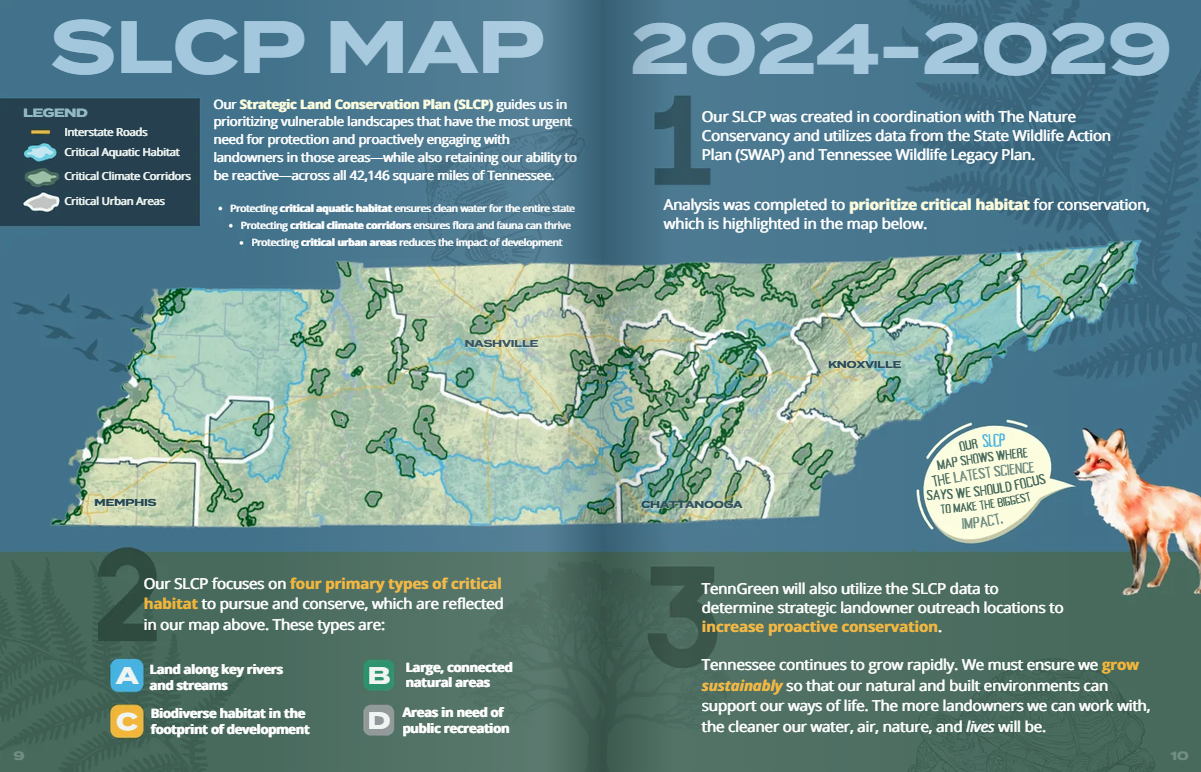TennGreen Land Conservancy works statewide, protecting diverse landscapes from idyllic waterfalls to working farms. Over the past 25 years, we’ve proudly protected the conservation values of over 50,000 acres.
However, as more and more people move to Tennessee every year—straining both our built and natural environments—the urgency to grow sustainably and preserve the integrity of our natural resources is only increasing. In turn, TennGreen needed to utilize a way to swiftly and strategically expand its capacity to tackle these new challenges.
In 2019, TennGreen decided to adopt a proactive approach to land conservation—that is, seeking out and prioritizing vulnerable landscapes that have the most urgent need for protection—while also still retaining a reactive model, too. But how to identify these priorities across all 42,146 square miles of the state of Tennessee? Cue the Strategic Land Conservation Plan, or SLCP for short.
Using data like rates of urbanization, priority habitat for rare species, and where conservation work has historically been done, TennGreen produced four core focal types for the SLCP:
- Lands along rivers and streams
- Large, connected natural areas
- Land for public benefit
- Biodiverse lands under the threat of development
Below, you’ll find the maps, science, and sources that correspond with these four core focal types.
Aquatic Focal Area

The Nature Conservancy helped TennGreen prioritize the streams and respective tributaries most in need of protection*. The watersheds of these streams are what TennGreen now considers its Aquatic Focal Areas. A watershed is an area of land wherein all the smaller streams flow into a single body of water. For example, all the land within the Harpeth River Watershed ultimately drains into the Harpeth River.
Climate Corridor Focal Area

A climate corridor is large, contiguous or connected habitat. Climate corridors are very important for large animals that require a large land area to thrive. Climate corridors also play an important role in ecosystem services like carbon sequestration. It’s integral to preserve these large swaths of undisturbed land today, because once a corridor is terminated, it can be difficult to impossible to reconnect.
Yet some critically endangered species are located in fragmented habitat. These broken-up habitats will not be part of a climate corridor even though they’re still incredibly important. An example an important landscape that is excluded from the SLCP is grasslands. Most of the southeastern United States used to be grasslands—but less than 10% remains today. In kind, TennGreen will work with partners to protect these imperative habitats, too.
Land for Public Benefit

In addition to conserving landscapes for the sake of wildlife and ecosystem services, TennGreen prioritizes equitable access to natural spaces. The Nature Conservancy helped TennGreen determine how far on average local residents must travel to access a local park*.
*Note: Data does not include city and county parks, as the existence of such small data may be limited.
Green represents areas where local residents needn’t travel far, whereas red represents areas where folks do have to travel far. So, helping acquire and establish new parks in the red areas should be prioritized. At TennGreen, we want everyone to have access to public spaces, regardless of their landownership.
TennGreen hopes to expand on this strategic focal area category by incorporating cultural and community resources, like archeological sites, into the data.
Urban Focal Area

Lastly, and arguably most urgently, Tennessee is growing—and it’s growing fast. We must ensure we grow sustainably so that our natural and built environments can still support our ways of life. In the Urban Focal Area map, TennGreen and The Nature Conservancy took into consideration high priority lands as described by the 2015 Tennessee State Wildlife Action Plan (SWAP) and compared these priority lands to urban growth predictions. It is in these areas that there’s no tomorrow to take action. We must act now!
One unique area in the Urban Focal Area is the Cedars of Lebanon complex. Cedar glades are flat and typically without many trees, which makes them very vulnerable to development. But cedar glades are also home to many endemic species: plants and animals that occur nowhere else in the whole world. TennGreen works urgently and diligently to protect this rapidly urbanizing area, as well.
Adaptability is Key to the SLCP
Above all, TennGreen recognizes and values the SLCP’s nuances because land conservation work must be adaptable. In short, we’re using science to guide our work in a smart and sustainable way.
Moreover, the SLCP is a living document, and TennGreen’s priorities will evolve over time. To learn more about how we aim to protect our brilliant state in the near future, you can view our 2024-2029 Strategic Plan booklet here.
From all of us at TennGreen, thank you for your interest and support. We couldn’t do any of this without you!
Other Ways to Help

